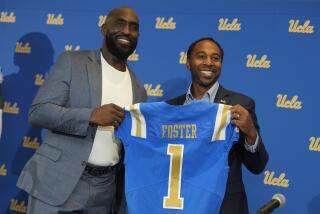Gender Equity Gets Boost : College sports: Cal State system’s plan to bring women’s opportunities in line with men’s could have nationwide ramifications.
- Share via
The movement toward gender equity in college athletics picked up momentum Thursday when the California State University system announced that it will require its schools to bring participation opportunities and funding for women’s sports in line with men’s sports by 1998-99.
The action, part of a settlement of a lawsuit filed in February by the California chapter of the National Organization for Women against the 20-school CSU system, could force some CSU schools to reduce financial commitments to football. Many will have to add women’s teams, and some might have to trim men’s programs.
The agreement is also a warning to University of California system schools and other institutions not complying with gender-equity laws.
“In some ways the job has only begun,” said Linda Joplin, California NOW state coordinator. “Now, we have to monitor compliance and move forward to make sure equity is implemented at all levels, from high schools to community colleges to colleges.”
A 1991-92 Times survey of the state’s college athletic departments revealed that of UCLA’s $12.3-million athletic budget, $2 million, or about 17%, went to women’s sports. The school recently cut men’s and women’s gymnastics and men’s swimming but suspended the decision on women’s gymnastics after a lawsuit was threatened. Of the University of California’s $12.7-million athletic budget in 1991-92, $2.9 million, or 23%, went to women.
Those figures would appear to put both schools in clear violation of California Education Codes requiring equal opportunities for women in athletics.
Asked if the UC system was next on NOW’s list, Jared Huffman, one of the San Francisco attorneys representing NOW, said, “It’s a logical choice. I can’t comment on whether a suit is in the works, but we would invite them to sit down at the negotiation table now so they could take steps toward gender equity instead of finding themselves on the wrong end of a lawsuit.”
Huffman said the agreement could also have nationwide ramifications for schools with multimillion-dollar football programs, which award up to 92 full scholarships and account for large percentages of athletic departments’ travel and equipment budgets.
“The bottom line is, some day schools are going to have to reconsider the way their NCAA Division I football programs are run,” Huffman said. “If they were smart, they’d start lobbying the NCAA to lower the number of scholarships. Schools should cut back on rosters and recruiting. They’re killing other sports programs, because football budgets are so huge.”
NOW’s suit against the CSU system was sparked by a suit by the Cal State Fullerton women’s volleyball team against the school in 1992. Fullerton had dropped volleyball, and the suit led to an out-of-court settlement in which Fullerton agreed to reinstate the program and adopt a 10-year plan to achieve athletic gender equity.
A 1988-1989 CSU survey revealed that 53% of the system’s 347,000 students were women--that figure has since risen to 55.5%--but only 30% of its student-athletes were women. Federal Title IX laws require athletic opportunities to be proportional to student body ratios. The survey also revealed that men received 74% of athletic department funds, women 25%, and coeducational teams 1%.
The new settlement requires each of the 19 CSU campuses with NCAA intercollegiate athletic programs to:
--Provide athletic opportunities for women proportional to the number of NCAA-eligible female undergraduates on each campus, within 5%.
--Provide grants-in-aid for women’s sports in proportion to the number of eligible female undergraduates on each campus, within 5%.
--Provide overall funding for women’s sports in proportion to the number of eligible female undergraduates on campus, within 10%.
Men’s programs were allowed the 5% and 10% variances as a concession to schools with football, which costs more to play and has more participants than other NCAA sports.
Times Staff Writer Scott Miller contributed to this story.
More to Read
Go beyond the scoreboard
Get the latest on L.A.'s teams in the daily Sports Report newsletter.
You may occasionally receive promotional content from the Los Angeles Times.











